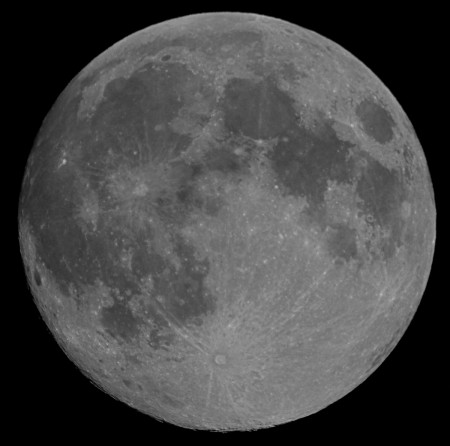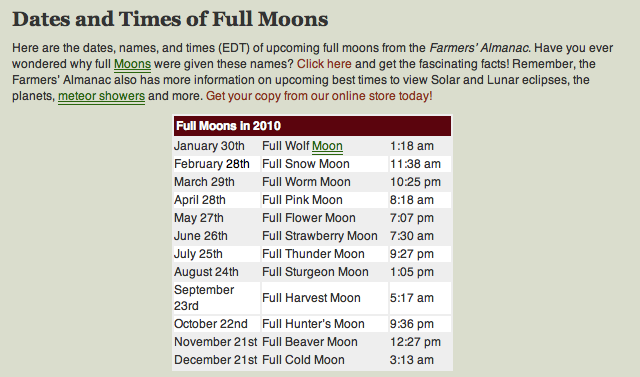The moon goes by many different names. Here are the moon names for August according to MoonPhase, one of my favorite lunar apps for my iPod (and iPad, but I’m consulting the iPod version because Someone Who Shall Remain Nameless drained the battery last night and didn’t plug it in so it’s recharging from the wall charger):
- August (Calendar Month)
- Dog Days (in Colonial American parlance)
- Sturgeon (Algonquin, which was the basis for the Farmers’ Almanac moon names)
- Grain (English)
- Dispute (Celtic)
- Wyrt (Medieval wiccan)
- Lightning (Neo pagan).
Whatever you call it, it happens today at 1:05 p.m. EDT. And as you may recall from previous full moon posts, I don’t like to take clear weather for granted, so I went out last night to shoot the moon. Here is how I found it at 15 hours before full:
Libration was pretty minimal; the eastern limb was slightly turned toward Earth (1 degree past neutral) and the southern limb was tilted our direction by 3 degrees. Not too much “extra” on the face of the moon last night, and there will be even less tonight (a bit more southern limb, but bang on neutral east–west).
If you recall the question of moon names from previous posts, you might like this very good explanation of the two different systems for naming the full moon. That is, whatever actual name you choose to assign to the full moon (Dog Days, Sturgeon, etc.), in whatever tradition (Colonial American, Farmers’ Almanac, etc.), you will be assigning it based on one of two methods: the (straightforward) “monthly” system (in which the full moon of January gets the first name of the system: Winter moon, January Moon, Cold moon, etc.) or the more involved, but much more seasonally consistent “seasonal” method. The seasonal method involves knowing where you are in relation to the solstices and equinoxes. That is, you need to know what season you’re in, so that you can name the moons appropriately over a longer term. For example, December is the “last” month of the calendar year, but the “first” month of the Winter season.
The difference between the two systems shows up most clearly around the solstices and equinoxes. For example, if, like in 2009, there’s a full moon in December after the Solstice, that moon would have the first name in the series in the seasonal system, but the last name in the series under the monthly rules.
And, if you recall, December 2009 posed a problem because there were two full moons! That made it a blue moon month under the monthly system. Under the seasonal system, though, there was no blue moon in December 2009. There was just the last full moon of autumn (December 1) and the first full moon of winter (December 31). Blue moons can only occur in February, May, August, or November in this method, because it’s the third full moon in a season that has four the blue moon. (Remember? I wrote about this earlier. And if that post isn’t readable enough, you can try this one.)
Regardless of which computus you’re using, though, you still need to name your moons. And I like the Colonial American moon names best, so those are the ones I use, for the most part, in these posts. Others prefer the Farmers’ Almanac names. I reproduce a chart from their website with the moon names for 2010. A prize to the person who spots the irony in this table (think November):
That’s right. The Maine Farmers’ Almanac, the people who originated the seasonal blue moon rule, list November’s moon, the third moon in a four-moon season, as Full Beaver Moon. I assume this is because there are only 12 moons in this calendar year, so they didn’t have an “extra” moon to name?
Getting back to last night’s moon, though, I still want to get to the bottom of this idea of Dog Days moon. If you believe Wikipedia, the “actual” dog days (“the hottest, most sultry days of summer”) arrive at different times of the year depending on latitude and climate, but I’m afraid I’m a bit more traditional than that. I maintain that the best definition of dog days, at least in the Northern Hemisphere, are those 30 to 40 days surrounding the heliacal rising of Sirius, the Dog Star.
To be fair, the Wikipedia article does mention this definition as well, but it relegates it to the “also defined as” ghetto. But to be even more fair, Wikipedia’s notion that the dog days vary by latitude is “right,” but for the wrong reasons! It’s not just that the hottest, most sultry days of summer arrive at different times of the year depending on how far north of the equator you are; the actual heliacal rising of Sirius varies by over a month in the Northern Hemisphere! As a a matter of fact, the heliacal rising of Sirius at my latitude (roughly 26° N) was nearly a month ago, during the so-called Summer Moon! And it was even earlier (July 17) at the latitude of Heliopolis when this idea appears to have originated (now it occurs on August 4 at that latitude, but that’s because thousands of years of precession have changed things).
If we go by the modern definition of dog days as the hottest days of summer, then here in South Florida they can start as early as June (or even May if you’ve just moved to our fair clime), and they don’t end until late September. Even Halloween is pretty hot here; poor little Eric was sweating like a monster in his dinosaur costume two years ago, and he was one hot sweaty little bee last year!
But I digress. As always, here is the gallery of the full moons of 2010:
References
Holberg, J.B. (2007). Sirius: Brightest Diamond in the Night Sky. NY: Springer.







































